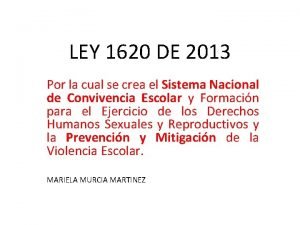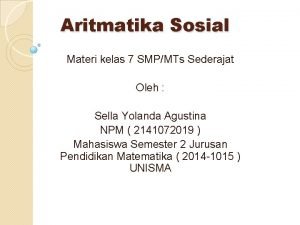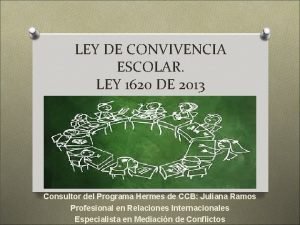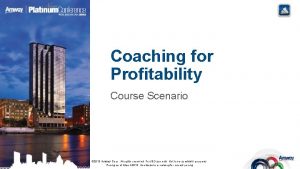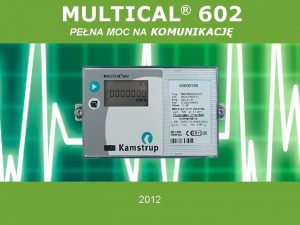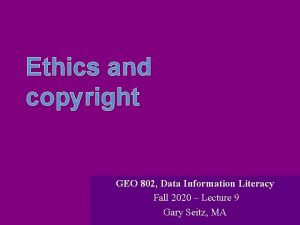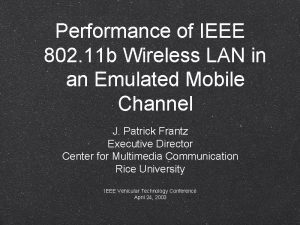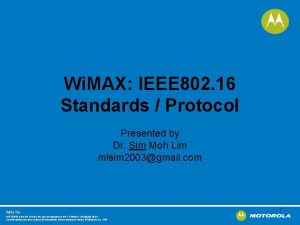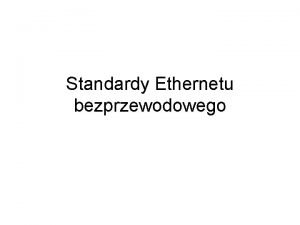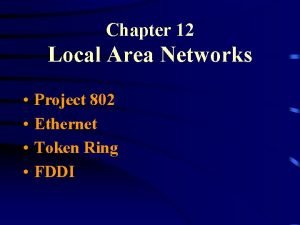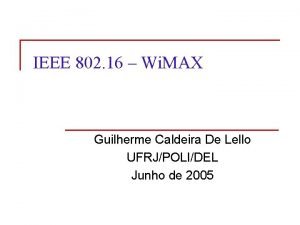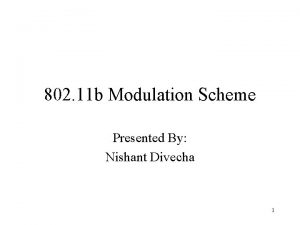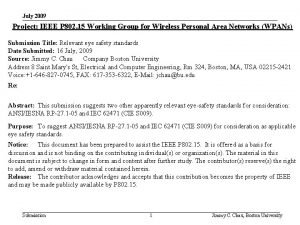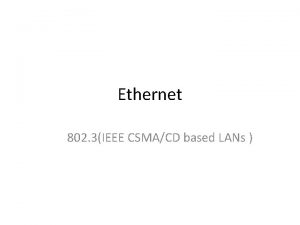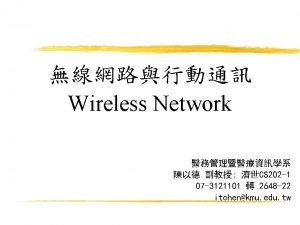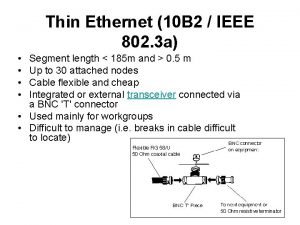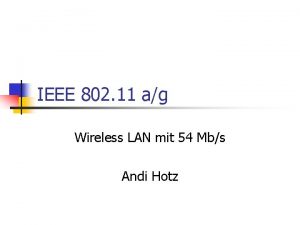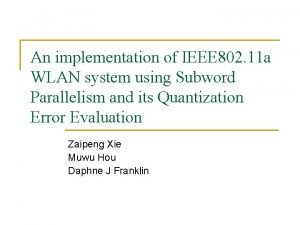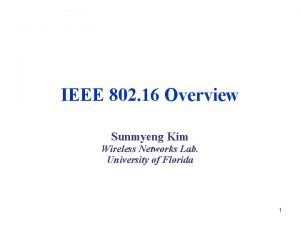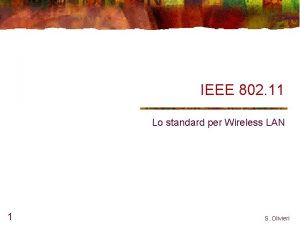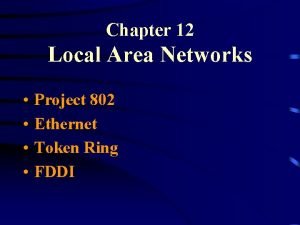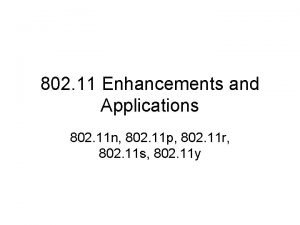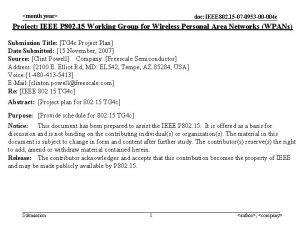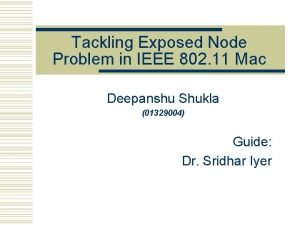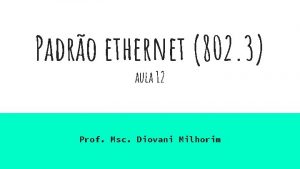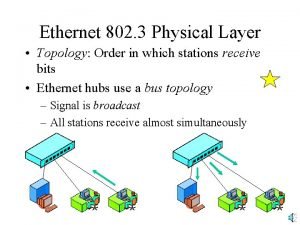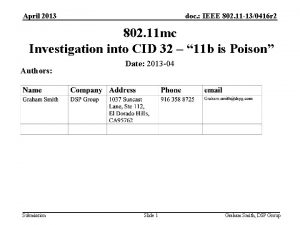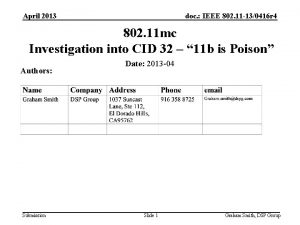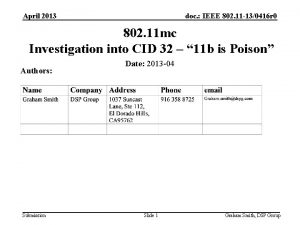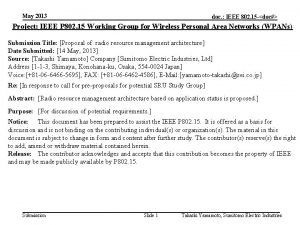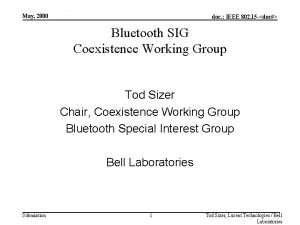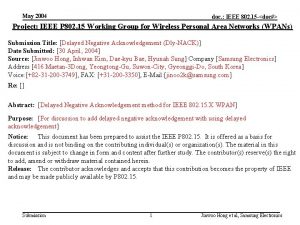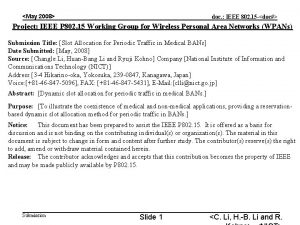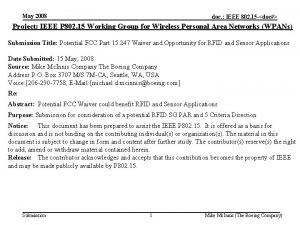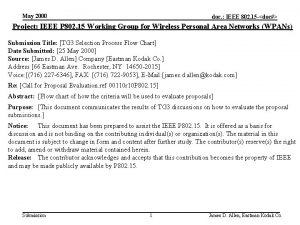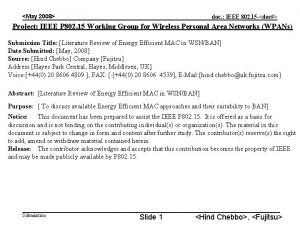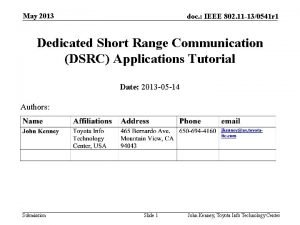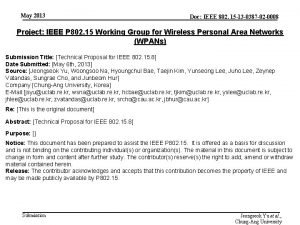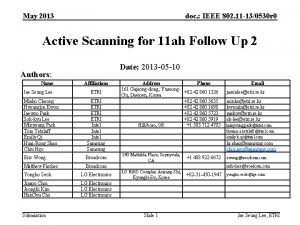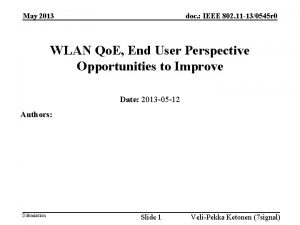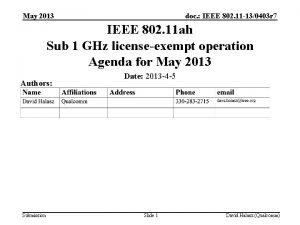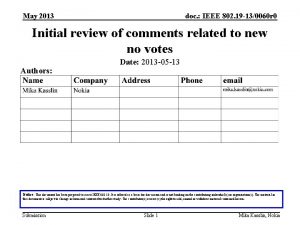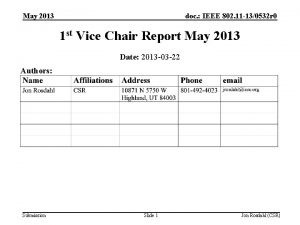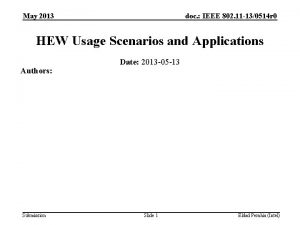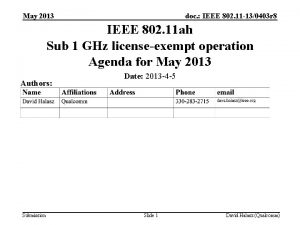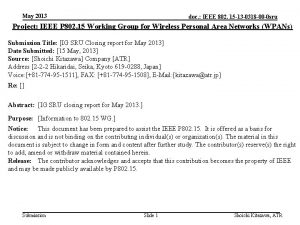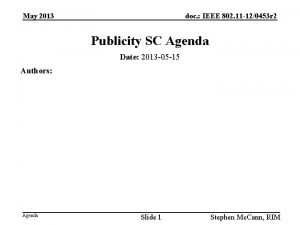May 2013 doc IEEE 802 11 130416 r












































- Slides: 44

May 2013 doc. : IEEE 802. 11 -13/0416 r 5 802. 11 mc Investigation into CID 32 – “ 11 b is Poison” Authors: Submission Date: 2013 -04 Slide 1 Graham Smith, DSP Group

May 2013 doc. : IEEE 802. 11 -13/0416 r 5 Background • It has been proposed, CID 32, that 11 b be dropped • This presentation investigates technical areas between using 1 Mbps DSSS and 6 Mbps OFDM. Submission Slide 2 Graham Smith, DSP Group

May 2013 doc. : IEEE 802. 11 -13/0416 r 5 Areas for consideration • • Range Network capacity Association time Power consumption issues Submission Slide 3 Graham Smith, DSP Group

May 2013 doc. : IEEE 802. 11 -13/0416 r 5 Sensitivity Note: I have considered the range question in some detail because this is the most common reason that is quoted for keeping 11 b. We must be careful when simply looking at data sheets. • OFDM receive sensitivity is 10% PER for 1000 B packet (802. 11 2012 - 18. 3. 10. 2) • DSSS receive sensitivity is 8% PER for 1024 B packet (802. 11 2012 – 16/17. 4. 8. 2) • We see varying differences of the sensitivity for 1 Mbps and 6 Mbps in data sheets of 1 – 10 d. B. Note: It is not known whether all data sheets do measure sensitivity exactly to the specification or under equal conditions. To avoid any misconceptions, let’s look at the required theoretical SNR: • 1 Mbps DSSS and 6 Mbps OFDM both use DBPSK modulation • We will use the same conditions, 10% PER, 1000 B packet Submission Slide 4 Graham Smith, DSP Group

May 2013 doc. : IEEE 802. 11 -13/0416 r 5 BPSK • The probability of a bit error for DBPSK is • Pb=0. 5 exp (-Eb/No) • The Packet Error Rate, PER is PER = 1 -(1 -Pb)^n • Where, n is the number of bits in the packet. (Many references) • Hence, for PER = 10%, Packet 1000 B – Pb = 1. 32 E-05 – Eb/No = 10. 2 d. B Note: Eb/No is energy per bit/ Noise per Hertz For BPSK, SNR = Eb/No. Submission Slide 5 Graham Smith, DSP Group

May 2013 doc. : IEEE 802. 11 -13/0416 r 5 Sensitivity 1 Mbps DSSS • For BPSK for PER 10% with 1000 B packet – Eb/No or SNR is 10. 2 d. B – Pb = BER = 1. 32 E-05 • The Processing gain for DSSS is from the 11 bit Barker spreading code 10 log(11)= 10. 4 d. B • Hence, theoretical best SNR for 1 Mbps = - 0. 2 d. B Submission Slide 6 Graham Smith, DSP Group

May 2013 doc. : IEEE 802. 11 -13/0416 r 5 Sensitivity – 6 Mbps The coding gain is due to the convolutional coding, R=1/2, Constraint length 7. Note that theoretical Coding Gain = 10 log(rate x Dfree) = 10 log (1/2. 10) = 7 d. B ) Coding Gain = 5. 5 d. B ELEC 7073 Digital Communications III, Dept. of E. E. E. , HKU Submission ECEN 5682 Theory and Practice of Error Control Codes Convolutional Code Performance – Peter Mathys, Univ of Colorado 2007 Slide 7 Graham Smith, DSP Group

May 2013 doc. : IEEE 802. 11 -13/0416 r 5 Sensitivity Theoretically, required SNR for 1000 B packet for 10%PER is: • 1 Mbps SNR = 10. 2 – 10. 4 = - 0. 2 d. B (Note: 4 d. B often quoted as SNR requirement) Minimum SNR*=10 d. B for 11 Mbps, 8 d. B for 5. 5 Mbps, 6 d. B for 2 Mbps, 4 d. B for 1 Mbps (IEEE 19. 5. 1 for a 8% BER) =16 d. B for 11 Mbps, 11 d. B for 5. 5 Mbps, 7 d. B for 2 Mbps, 4 d. B for 1 Mbps (Industry products for a 10% BER) Columbis Univ http: //www. cisl. columbia. edu/grads/ozgun/Project. Application. html • 6 Mbps SNR = 10. 2– 5. 5 = 4. 7 d. B (Note: EVM spec is -5 d. B (802. 11 - 2012 Table 18 -13 ) Sensitivity Pr = -174 + 10 log BW +NF + SNR d. Bs For BW = 16. 5 MHz (see next slide), NF = 9 d. B, we get: 1 Mbps Pr = -95. 3 d. Bm 6 Mbps Pr = -90. 4 d. Bm This looks reasonable and seems to be in the right ballpark. Therefore, for AWGN 1 Mbps has a theoretical 4. 9 d. B advantage in sensitivity over 6 Mbps (No implementation losses) Submission Slide 8 Graham Smith, DSP Group

May 2013 doc. : IEEE 802. 11 -13/0416 r 5 Bandwidth • The received noise is proportional to the channel bandwidth • The occupied bandwidth for both OFDM and DSSS is 16. 5 MHz, Submission Slide 9 Graham Smith, DSP Group

May 2013 doc. : IEEE 802. 11 -13/0416 r 5 Practical Channels • The 4. 9 d. B sensitivity difference is theoretical for SNR with AWGN, • What is important is the actual performance over the air. • In practice, the propagation will normally be subject to multipath, delay spread • Fading channel models – Rayleigh – no LOS – Rician – some LOS – Nagasaki – some LOS Submission Slide 10 Graham Smith, DSP Group

May 2013 doc. : IEEE 802. 11 -13/0416 r 5 NLOS channel - Rician • It is common to use the Rician Distribution to model the channel. K = 0 , Rayleigh distribution, no LOS K = 10, outdoor, suburban and indoor with some LOS K = 20, outdoor urban K = 1000, strong LOS (AWGN) Submission Slide 11 Graham Smith, DSP Group

May 2013 doc. : IEEE 802. 11 -13/0416 r 5 Nakagami - m • The Nakagami-m distribution is used to model fading channel conditions that are either more or less severe than the Rayleigh distribution (m=1). For small values of m (i. e. , 0. 5 ≤ m ≤ 1), the fading conditions are severe, while for larger values of m the fading conditions are less severe. As m → ∞ , no fading is present. Submission Slide 12 Graham Smith, DSP Group

doc. : IEEE 802. 11 -13/0416 r 5 BPSK in Rayleigh fading channel Ref: Kristna Sanka, DSPLOG 2008 Reference: Proakis – Digital Comms Note 35 d. B SNR at 1 e-04, rising to over 42 d. B at 1 e-05 So basic BPSK is not good in Rayleigh fading channels Submission Slide 13 Graham Smith, DSP Group

doc. : IEEE 802. 11 -13/0416 r 5 DPSK in Rayleigh Fading Eb/No = 11 d. B For BER 10 -5 Ref: Andrea Goldsmith, Wireless Comms, 2005 Ave Pb = 1/(2(1+Eb/No)) in Rayleigh fading Agrees generally with previous graph, DPSK is not good in Rayleigh fading Submission Slide 14 Graham Smith, DSP Group

May 2013 doc. : IEEE 802. 11 -13/0416 r 5 Fading – Coherence bandwidth • • • Systems operating within the Coherence bandwidth* have flat fading Systems operating greater than the Coherence bandwidth have selective fading Coherence bandwidth is related to the delay time spread With 16. 5 MHz BW, selective fading will be experienced for delay spreads of about 30 ns and more*. The 11 n channel models (Erceg et al , 2004) – 15 ns Residential Intra-room, room-room – 30 ns Residential/Small Office Conference room, classroom – 50 ns Typical Office Sea of cubes, large conference room – 100 ns Large Office Multi-storey, campus small hotspots – 150 ns Large Space Large hotspot, industrial, city square Hence, both 1 Mbps and 6 Mbps will suffer from selective fading over most conditions. *Note: Coherence BW Bc = 1/(4πT) where T = Delay Spread Ref: Foundations of Mobile Radio Engineering, Yacoub Submission Slide 15 Graham Smith, DSP Group

May 2013 doc. : IEEE 802. 11 -13/0416 r 5 Selective Fading - Examples Use ray tracing to produce delays Room 100 ft by 70 feet (x, y) Ceiling 20 ft RX position 65, 44 (3 ft off ground) Y 10 d. B obstruction to direct and floor rays X Position A 21, 45 (delays 23 -100 ns) Position B 30, 45 (delays 27 to 102 ns) Position C 13, 45 (delays 21 to 99 ns) Fades up to 25 d. B Show spread sheet if time Submission Slide 16 Graham Smith, DSP Group

May 2013 doc. : IEEE 802. 11 -13/0416 r 5 Selective Fading, Delay Spread TX Position 22, 45 RX position 65, 44 5 d. B attenuation to direct and floor rays 25 d. B Deep Fade Submission Delay Spread about 30 -40 ns Slide 17 Graham Smith, DSP Group

May 2013 doc. : IEEE 802. 11 -13/0416 r 5 Fading - DSSS • Selective Fading can cause problems with the correlation of the Barker code which is only 11 bits. Chipping rate is 11 Mbps, 90. 9 ns per bit, hence: • Large Multipath delays can cause inter symbol distortion. – Delayed signal will interfere with the start of a signal that has less delay. • Basically, DSSS does not have much protection to multipath fading. Submission Slide 18 Graham Smith, DSP Group

May 2013 doc. : IEEE 802. 11 -13/0416 r 5 Fading - OFDM • OFDM uses convolutional coding • Adds redundancy bits (1/2 rate 1 code bit added to every data bit) • Encodes bits across several symbols (Constraint limit of 7) • Can correct ~50% bit errors Compare to DSSS which only accepts 2 errors in 11 (<20%) – Uses scrambling to avoid selective fading – Uses SNR weighting on Viterbi decoder • OFDM uses Guard Interval to protect against excessive delay spread. OFDM is designed to counter multipath fading. Submission Slide 19 Graham Smith, DSP Group

doc. : IEEE 802. 11 -13/0416 r 5 11 b 1 Mbps in fading Rician channel Rayleigh Faded channel requires Eb/No of 36 d. B (k=0), and 9 d. B for outdoor urban channel (k = 20) BER Analysis of 802. 11 b Networks under Mobility, Puttipong Mahasukhon, et al Computer and Electronics Engineering Department University of Nebraska-Lincoln Submission Slide 20 Graham Smith, DSP Group

doc. : IEEE 802. 11 -13/0416 r 5 OFDM 6 Mbps in fading channel Eb/No for Rayleigh Channel = 8. 5 d. B Eb/No for m = 4 is 5. 5 d. B (This is comparable with Rican k = 20) Performance Analysis of IEEE 802. 11 g Waveform Transmitted Over A Fading Channel with Pulse-Noise Interference, Konstantinos Taxeidis, Naval Postgraduate School, Monterey, CA, 2006 Submission Slide 21 Graham Smith, DSP Group

doc. : IEEE 802. 11 -13/0416 r 5 12 Mbps BER and PER AWNG and fading AWGN BER 10 -5 Eb/No = 5. 5 d. B Rayleigh Fading 10% PER Eb/No = 10 d. B Ref: OFDM Wireless LANs, John Heiskala, John Terry, 2002 Submission Slide 22 Graham Smith, DSP Group

May 2013 doc. : IEEE 802. 11 -13/0416 r 5 Range Performance comparison • Receive Sensitivity (AWGN) – 1 Mbps DSSS is 2 - 4. 9 d. B more sensitive than 6 Mbps OFDM • Performance in a fading channel (simulated) – 6 Mbps is 27 d. B better performance than 1 Mbps in Rayleigh fading – 6 Mbps is 4. 5 d. B better performance than 1 Mbps in Rician (k=20) fading (outdoor urban with some LOS) Based upon these results, in practice, unless the path is highly LOS, 6 Mbps range will be comparable if not superior to 1 Mbps. Submission Slide 23 Graham Smith, DSP Group

May 2013 doc. : IEEE 802. 11 -13/0416 r 5 1 Mbps vs 6 Mbps Range • If perfect LOS 1 Mbps has a theoretical 12 -32% improvement in range over 6 Mbps • In normal indoor environment, 6 Mbps has a theoretical 12% advantage in range over 1 Mbps – Assumes Rician k=20 – SNR 1 Mbps = 9 d. B, 6 Mbps = 7 d. B for 10% PER 1000 B packets • In no LOS conditions (Rayleigh fading) 6 Mbps has a 5 x advantage in range over 1 Mbps – SNR 1 Mbps = 36 d. B, 6 Mbps = 11 d. B for 10% PER 1000 B packet Conclusion: THERE IS DOUBT IF THERE IS A REAL OVERALL ADVANTAGE TO USE 1 Mbps over 6 Mbps for RANGE REASONS BUT definitely MORE WORK REQUIRED to definitively prove this Submission Slide 24 Graham Smith, DSP Group

May 2013 doc. : IEEE 802. 11 -13/0416 r 5 Areas for consideration • • Range Network capacity Association time Power consumption issues Submission Slide 25 Graham Smith, DSP Group

May 2013 doc. : IEEE 802. 11 -13/0416 r 5 Throughputs – 11 b Protection • When 11 b STA is in the network, ‘protection’ is used (CTS-to-Self) – CTS-to-Self must be sent at 11 b rate. Theoretically safest is to send at 1 Mbps BUT most implementations use 11 Mbps CTS-to-Self, (1 Mbps is too harmful) – 11 g, no protection, throughput @54 Mbps = 27 Mbps – 11 g, with protection, throughput @ 54 Mbps = 21 Mbps, if 11 Mbps CTS – 11 n, no protection, throughput @130 Mbps = 36 Mbps (no aggregation) – 11 n, with protection, throughput @130 Mbps = 27 Mbps, 11 Mbps CTS 25% loss of capacity due to use of 11 b protection alone. Submission Slide 26 Graham Smith, DSP Group

May 2013 doc. : IEEE 802. 11 -13/0416 r 5 Throughput – Mixed Mode, 11 Mbps • When one OFDM and one 11 b are competing, theoretical overall throughput is significantly reduced, even if 11 Mbps (short preamble) used – Theoretical analysis with no fallback, in practice will be worse than this. If both compete then overall throughput is reduced to 15 Mbps total in theory, practice has shown even worse results (see WPA 2 Test Plan very low pass marks) Compare the mixed mode throughputs to 36 Mbps for 11 n and 27 Mbps for 11 g Submission Slide 27 Graham Smith, DSP Group

May 2013 doc. : IEEE 802. 11 -13/0416 r 5 Mixed Mode Throughput – 1 Mbps • BUT if we look at mixed mode 1 Mbps and OFDM 11 b at 1 Mbps 54 Mbps 130 Mbps 65 k Agg 0 26 Mbps 36 Mbps 115 Mbps Protection 21 Mbps 27 Mbps 113 Mbps 0. 87 Mbps 1. 7 Mbps 48 Mbps A 1 Mbps stream almost kills any other traffic. Only heavy aggregation overcomes. Note: The same number of packets are transmitted as for no aggregation, but each packet is now 46 MPDUs. Just 1 Mbps traffic at 1 Mbps 11 b PHY Rate, kills 11 g or 11 n no aggregation traffic - dead Submission Slide 28 Graham Smith, DSP Group

May 2013 doc. : IEEE 802. 11 -13/0416 r 5 Areas for consideration • • Range Network capacity Association time Power consumption issues Submission Slide 29 Graham Smith, DSP Group

May 2013 • doc. : IEEE 802. 11 -13/0416 r 5 Association consists of: – Probe Request and Response, – Authentication Request and Response, – Association Request and Response – 4 way handshake A simulation was written for 100 STAs as part of work for 11 ai. This was used to calculate the above times. All 10 STAs start simultaneously and the variation is due to the random selection of backoff slots for the 10 packets Association using 11 b only (Probes at 1 Mbps, all other packets at 11 Mbps) Time to complete per STA (zero processing time) = 8. 3 to 11 ms Time to complete per STA (5 ms processing time)= 60 ms Association using OFDM only (Probes at 6 Mbps, all other packets at 24 Mbps) Time to complete per STA (zero processing time) = 3 ms Time to complete per STA (5 ms processing time) = 47 ms (Dominated by Processing time) Submission Slide 30 Graham Smith, DSP Group

May 2013 doc. : IEEE 802. 11 -13/0416 r 5 Association – If all packets sent at 1 Mbps , total time for all 10 STAs to complete = 220 -300 ms assuming zero processing time – If Probes sent at 1 Mbps, all other packets at 11 Mbps, time = 83 – 109 ms This is minimum time using 11 b – If all at 6 Mbps, then total time for 10 STAs is 44– 50 ms This would be the maximum time if OFDM only. – If Probes sent at 6 Mbps, all other packets at 24 Mbps, time = 26 – 36 ms This is average, minimum time using OFDM – Compare 83 – 109 ms with 26 – 36 ms – OFDM is at least 3 x faster. Submission Slide 31 Graham Smith, DSP Group

May 2013 doc. : IEEE 802. 11 -13/0416 r 5 Areas for consideration • • Range Network capacity Association time Power consumption issues Submission Slide 32 Graham Smith, DSP Group

May 2013 doc. : IEEE 802. 11 -13/0416 r 5 Power Consumption – Power Amplifier • Power Amplifier – 6 Mbps OFDM requires -5 d. B EVM – 1 Mbps DSSS requires 4 d. B SNR, (or -4 d. B EVM) – 11 Mbps CCK requires 12 d. B SNR (or -12 d. B EVM) – – At -5 d. B EVM, the OFDM PA can be just as efficient as an 11 b only PA. Note that • 6 Mbps = -5 d. B or 56. 2% EVM • 12 Mbps = -10 d. B or 31. 6% EVM • 18 Mbps = -13 d. B or 22. 4% EVM (Note that 18 Mbps is comparable to 11 Mbps for EVM) • 24 Mbps = -16 d. B or 15. 8% EVM At all these rates the PA can be at full gain and output (usually specifying 3 -5% EVM) As far as PA is concerned there is no practical power consumption penalty between 11 b and the lower rates of OFDM (up to 24 Mbps) It is true that the OFDM PAPR means that a backoff of about 4 d. B is required, so a PA design solely for 11 b may have some advantage, but it would be negligible. New OFDM PA designs such as Doherty amplifiers are achieving 70% efficiencies for low EVM <5% Submission Slide 33 Graham Smith, DSP Group

May 2013 doc. : IEEE 802. 11 -13/0416 r 5 Power Consumption – On Air Time • For comparison purposes we look at the packet + ACK duration for various packet sizes. We compare • 1 Mbps time vs. or 6 Mbps (minimum rate) • 11 Mbps time vs. 12 Mbps (comparable PHY rate) • 11 Mbps time vs. 24 Mbps (highest basic rate) 1 Mbps duration 6 x that for 6 Mbps 11 Mbps duration 1. 2 to 1. 7 x that for 12 Mbps Packet durations are significantly less for OFDM compared to 11 b Note: In all calculations 11 Mbps Short Preamble is used. Submission Slide 34 Graham Smith, DSP Group

May 2013 doc. : IEEE 802. 11 -13/0416 r 5 Power Consumption – Beacons • Assuming a beacon of 160 B, time on air is – 1472 us for 1 Mbps – 240 us for 6 Mbps Beacon is 1/6 duration at 6 Mbps compared to 1 Mbps. Submission Slide 35 Graham Smith, DSP Group

May 2013 doc. : IEEE 802. 11 -13/0416 r 5 Power Consumption Comparing an 11 g OFDM Only device with 11 b/g device • Association time is 3 -5 times quicker • Beacons are 1/6 the time at 6 Mbps cf 1 Mbps • Packet durations are less than ½ at the higher rates (24 Mbps vs. 11 Mbps) – Short packets are even more efficient up to 1/3 • Hence, time on air to associate or transmit/receive packets is significantly less for OFDM compared to 11 b – Time to wake up, associate, send 100 B packet using 11 b is 443 us (1 and 11 Mbps) – Time to wake up, associate, send 100 B packet using OFDM is 158 us (6 and 24 Mbps) – 11 b is 3 x longer on air. Submission Slide 36 Graham Smith, DSP Group

May 2013 doc. : IEEE 802. 11 -13/0416 r 5 Summary and Comments • • • 1 Mbps has a 4. 6 d. B theoretical receive sensitivity advantage over 6 Mbps – This is only true for pure LOS channel (AWGN) – When considering fading channels, 6 Mbps has range advantage over NLOS paths. – For channels with some LOS (Rician k=20) then the range performance is comparable – 6 Mbps may well be the better for range when taken over most practical conditions – The statement that “ 1 Mbps has better range than 6 Mbps” is not true in many conditions Throughput is significantly (drastically if 11 b is 1 Mbps) reduced in a mixed mode network – The need to use ‘protection’ (CTS-to-Self) reduces the capacity of the network by 25% – Mixed mode total throughput is reduced by 58% for 11 g and 70% for 11 n (2 SS, 20 MHz, no agg) with 11 Mbps 11 b. – 1 Mbps 11 b traffic reduces total throughput to <2 Mbps unless aggregation is used, then still reduced by 76% even for 65 k aggregation. – Note that this is also true for overlapping networks Submission Slide 37 Graham Smith, DSP Group

May 2013 doc. : IEEE 802. 11 -13/0416 r 5 Summary and Comments • Beacon duration, Association time, packet durations are all significantly less at OFDM than with 11 b. Power Consumption would therefore benefit – Beacon duration is reduced by 84% if sent at 6 Mbps compared to 1 Mbps (240 us, cf 1472 us for 160 B beacon) – Time for a STA to Associate is reduced by 70%, but packet processing time can reduce this. – Packet duration for 11 Mbps compared to 12 Mbps (equivalent in receive sensitivity) are 1. 2 to 1. 7 longer for 1500 B and 100 B packets respectively. • Power Consumption is better for 2. 4 GHz OFDM only solution than for 11 b only or even mixed – Without the need for ’protection’ (which takes up time), and with the significantly reduced association times and packet durations power consumption has to be less. – PA design for 11 b only can be very efficient but present PAs are designed for 11 b/g hence they are only about 40% efficient to cater for the low EVM. Designing for only up to, say 24 Mbps (covering all the Basic Rates) would allow much higher efficiency for sensor type applications. Submission Slide 38 Graham Smith, DSP Group

May 2013 doc. : IEEE 802. 11 -13/0416 r 5 Summary and Comments • • • Power Amplifier – PA design for 11 b only can be very efficient but present PAs are designed for 11 b/g hence they are only about 40% efficient to cater for the low EVM. Designing for only up to, say 24 Mbps (EVM 16%) (covering all the Basic Rates) would allow much higher efficiency for Sensor. Net type applications. – For applications that presently use 11 b/g/n the PA is not optimized at all for the 11 b rates, so dropping 11 b makes no difference. – New designs using the Doherty amplifier and other similar techniques can raise the OFDM PA efficiently to 70% for EVM 5% or less (several papers recently presented at IEEE Radio Wireless Week, 2013) Catering for 11 b requires a separate Baseband for DSSS and CCK. This is totally separate and an extra expense. 11 b uses different SIFS, Slot times, CW and TXOPs all these cause confusion in implementations. Only one set of WMM parameters (including TXOP limits) is advertised so 11 b is not correctly covered anyway. Also devices will use 9 us slot time not 20 us even if using 11 b in an 11 g device. (Specification). Submission Slide 39 Graham Smith, DSP Group

May 2013 doc. : IEEE 802. 11 -13/0416 r 5 Conclusions • In all technical aspects other than the 2 -4. 9 d. B theoretical advantage in AWGN sensitivity of 1 Mbps over 6 Mbps, there is no reason why 11 b should be preferred in any scenario. The real life performance over real channels starts to favor 6 Mbps as the LOS conditions diminish. • A major problem is the mixed mode throughput where the existence of a 1 Mbps stream kills any overlapping or co-existing devices. If 11 b were dropped the mixed mode throughput problem would be solved. If nothing else this a major reason to drop 11 b. • Without any doubt the capacity of 2. 4 GHz networks is improved if ‘protection’ is not required. Many APs send CTS-to-Self automatically because of possibility of overlapping networks. Submission Slide 40 Graham Smith, DSP Group

May 2013 doc. : IEEE 802. 11 -13/0416 r 5 Questions • In view of the points presented, do you agree that: 1. It would be beneficial to 802. 11 if if 11 b was to be phased out? 2. Text to discourage use of 11 b be added to the Standard? 3. We should leave it alone and let the market deal with it? 4. Other? Submission Slide 41 Graham Smith, DSP Group

doc. : IEEE 802. 11 -13/0416 r 5 Additional Information Submission Slide 42 Graham Smith, DSP Group

May 2013 doc. : IEEE 802. 11 -13/0416 r 5 Range – Indoor Propagation • INDOOR Propagation – Distance factor is 40 log. D, or 12 d. B per octave – 2 d. B difference relates to a 12% difference in range – Also note that loss through a: • drywall is 3 d. B, • floor is 5 d. B • wall is 10 d. B – Indoor range, no obstructions ~ 442 ft, sensitivity -91 d. Bm – Indoor range, no obstructions ~ 394 ft, sensitivity -89 d. Bm 5 d. B Margin loss added (rule of thumb). • For 11 b this may need to be higher, ~9 d. B • For OFDM this is about right. Good indoor coverage with either Assuming a wall every 12 feet, -89 d. Bm just makes the 9 th room, -91 d. Bm just covers the 9 th room Submission Slide 43 Graham Smith, DSP Group

May 2013 doc. : IEEE 802. 11 -13/0416 r 5 Range – Outdoor Propagation • OUTDOOR Propagation – Distance factor is 35 log. D, or 10. 5 d. B per octave – 2 d. B difference relates to a 14% difference in range Using Hata, the range difference is 12% Note about 20 d. B extra loss between suburban and large urban environments. • For 11 b 1 Mbps this may be about right (9 d. B cf 36 d. B) • For 6 Mbps this is too much (7 d. B cf 11 d. B) Submission Slide 44 Graham Smith, DSP Group
 Bridges from 802.x to 802.y
Bridges from 802.x to 802.y Bridges from 802.x to 802.y
Bridges from 802.x to 802.y Estandares 802
Estandares 802 Ieee 802 standard
Ieee 802 standard Ieee 802 bluetooth
Ieee 802 bluetooth 802 ieee
802 ieee Ieee 802
Ieee 802 Ieee 802 family
Ieee 802 family Ieee 802 3 compliance
Ieee 802 3 compliance Wlan standards
Wlan standards Arquitetura ieee 802
Arquitetura ieee 802 Ley 1620 de 2013 situaciones tipo 1 2 y 3
Ley 1620 de 2013 situaciones tipo 1 2 y 3 Soal pajak aritmatika sosial kelas 7
Soal pajak aritmatika sosial kelas 7 Ruta de convivencia escolar ley 1620
Ruta de convivencia escolar ley 1620 Amway online renewal 2013
Amway online renewal 2013 Hci patterns
Hci patterns Komunikacj
Komunikacj Geo 802
Geo 802 802 11 b
802 11 b 802 16
802 16 Standardy 802
Standardy 802 802 5
802 5 Project 802 in data communication network
Project 802 in data communication network 802 16
802 16 802 protocols
802 protocols 802 11
802 11 Sybex ccna
Sybex ccna 09 802 0561
09 802 0561 Ethernet 802
Ethernet 802 802 family
802 family 802-3-ethernet
802-3-ethernet 802 701
802 701 Wireless lan 802
Wireless lan 802 Wlan 802
Wlan 802 Modulation coding scheme
Modulation coding scheme 802/11
802/11 Ssin-802
Ssin-802 Project 802
Project 802 Mac address
Mac address 802 11 n
802 11 n 802 15
802 15 Node 802
Node 802 507-802-380
507-802-380 802 3
802 3 Physical layer topology
Physical layer topology











